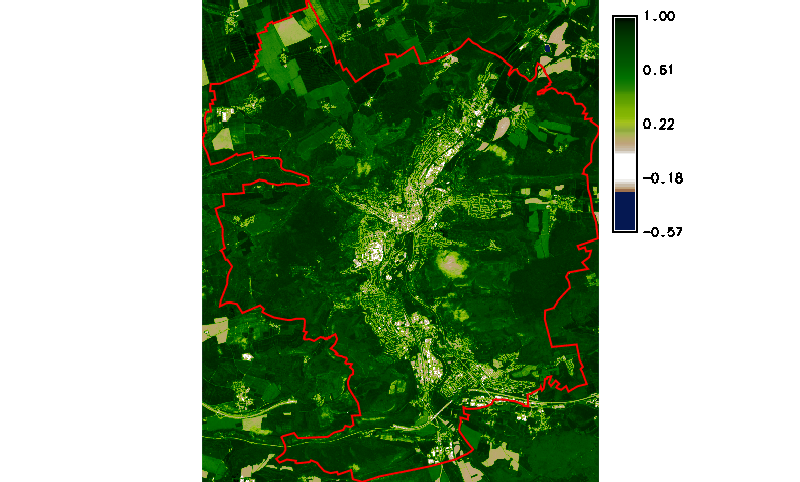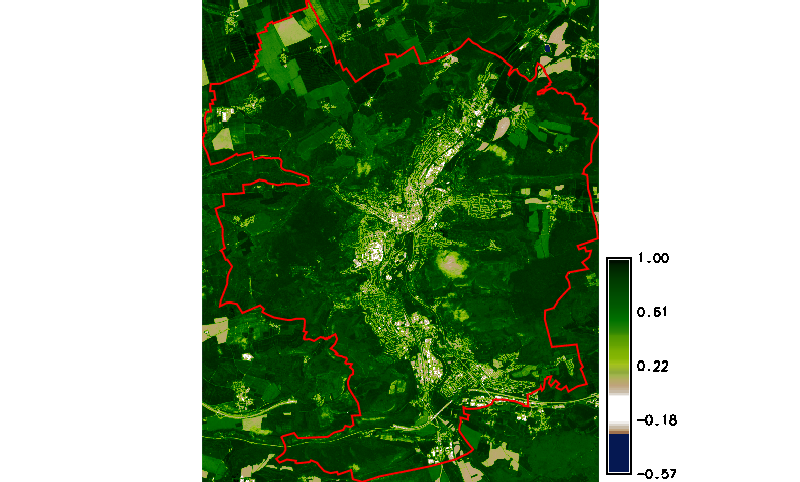Unit 21 - Sentinel spatio-temporal¶
Create a new mapset in jena-region location: sentinel_ndvi (don’t use dashes in the mapset name otherwise t.rast.algebra will most probably fail).
Todo
Fix t.rast.algebra to support also mapsets containing dash(es) in the name.
Download data¶
Important
Pre-downloaded Sentinel scenes are available in the
sample dataset geodata/sentinel. Readers can continue
with importing sample data.
Let’s download Sentinel L2A products for spring/summer 2021. There are 6 products available as shown below.
i.sentinel.download -l settings=sentinel.txt map=jena_boundary area_relation=Contains \
start=2021-04-01 end=2021-10-31 producttype=S2MSI2A clouds=10
6 Sentinel product(s) found
a844500a-049f-46a3-92de-bcda2c38fc3c ... 2021-05-31T10:15:59Z 2% S2MSI2A 1.09 GB
d5b73db9-0acf-401d-9bf4-a6f199df1119 ... 2021-09-08T10:15:59Z 3% S2MSI2A 1.09 GB
b00d5dfd-9cce-48c6-a011-fd46b85de814 ... 2021-09-03T10:20:21Z 3% S2MSI2A 1.09 GB
44644895-f6f9-4963-ab47-b5e122d3bf41 ... 2021-08-14T10:20:31Z 5% S2MSI2A 1.10 GB
dc92df2b-b69e-4081-88a6-bd4b95e4fc78 ... 2021-04-21T10:15:49Z 8% S2MSI2A 1.08 GB
2c02ac80-60ae-4376-9099-2267ad3a96b5 ... 2021-04-26T10:20:21Z 9% S2MSI2A 1.09 GB
Download selected Sentinel scenes:
i.sentinel.download settings=sentinel.txt map=jena_boundary area_relation=Contains \
start=2021-04-01 end=2021-10-31 producttype=S2MSI2A clouds=10 \
output=geodata/sentinel/2021
Import data¶
Data can be imported by i.sentinel.import similarly as
done in Unit 20 - Sentinel downloader. At fisrt check list of bands to be imported by
-p flag. Since NDVI is computed only 4th and 8th band are
selected. Use register_output in order to create timestamps
file. This file will be used for registering bands into space-time
raster dataset.
i.sentinel.import -p input=/home/user/geodata/sentinel/2019 pattern="B0[4|8]_10m"
i.sentinel.import -l -c input=/home/user/geodata/sentinel/2019 pattern="B0[4|8]_10m" \
register_output=/home/user/sentinel-timestamps.txt
Example of created timestamp file:
T32UPB_20190407T102021_B04_10m|2019-04-07 10:26:45.035007|S2_4
T32UPB_20190407T102021_B08_10m|2019-04-07 10:26:45.035007|S2_8
T32UPB_20190422T102029_B04_10m|2019-04-22 10:26:50.312683|S2_4
...
Create space-time dataset¶
At this moment a new space-time dataset can be created by means of t.create and all imported Sentinel bands registered with t.register.
t.create output=sentinel title="Sentinel L2A 2019" desc="Jena region"
t.register input=sentinel file=/home/user/sentinel-timestamps.txt
Let’s check basic metadata (t.info) and list the registered maps (t.rast.list).
t.info input=sentinel
...
| Start time:................. 2019-04-07 10:26:45.035007
| End time:................... 2019-10-14 10:26:46.742599
...
| Number of registered maps:.. 14
t.rast.list input=sentinel
name|mapset|start_time|end_time
T32UPB_20190407T102021_B04_10m|sentinel|2019-04-07 10:26:45.035007|None
T32UPB_20190407T102021_B08_10m|sentinel|2019-04-07 10:26:45.035007|None
T32UPB_20190417T102031_B04_10m|sentinel|2019-04-17 10:26:46.415802|None
...
NDVI ST computation¶
For NDVI computation 4th and 8th bands are required (Unit 05 - Raster processing). Map algebra for spatio-temporal data is performed by t.rast.algebra which requires bands separated into different spatio-temporal datasets (see example in Unit 22 - Spatio-temporal scripting). Such datasets can be prepared by t.rast.extract.
t.rast.extract input=sentinel where="name like '%B04%'" output=b4
t.rast.extract input=sentinel where="name like '%B08%'" output=b8
Let’s check content of the new datasets by t.rast.list.
t.rast.list input=b4
t.rast.list input=b8
Set computational region by g.region including mask for area of interest by r.mask.
g.region vector=jena_boundary align=T32UPB_20190407T102021_B04_10m
r.mask vector=jena_boundary
NDVI (see Unit 05 - Raster processing) computation on spatio-temporal datasets can be performed in parallel (nproc).
t.rast.algebra basename=ndvi expression="ndvi = float(b8 - b4) / ( b8 + b4 )" nprocs=3
Tip
GRASS 8 adds mechanism of semantic labels which makes computation much more straighforward using t.rast.mapcalc. NDVI can be computed directly using sentinel space-time dataset. No need for creating time series subsets as described above.
t.rast.mapcalc inputs=sentinel.S2_8,sentinel.S2_4 output=ndvi basename=ndvi \
expression="float(sentinel.S2_8 - sentinel.S2_4) / (sentinel.S2_8 + sentinel.S2_4)" \
nprocs=3
When computation is finished ndvi color table can be set with t.rast.colors.
t.rast.colors input=ndvi color=ndvi

Fig. 114 Simple NDVI animation (no clouds mask applied) created by g.gui.animation.
Important
Load data as multiple raster maps instead of space time dataset.
Cloud mask¶
Let’s apply the cloud masks on our NDVI space-time dataset. At first, we will create a new space-time dataset containing computed raster masks. A sample Python script has been designed for this purpose below. Masks can be created with r.mask, see line 50. But in this case, the mask should be kept for further usage. Note that r.mask module produces a normal raster map with the unique name MASK. To disable a mask, it is enough to rename the MASK map with g.rename, see line 52.
1 2 3 4 5 6 7 8 9 10 11 12 13 14 15 16 17 18 19 20 21 22 23 24 25 26 27 28 29 30 31 32 33 34 35 36 37 38 39 40 41 42 43 44 45 46 47 48 49 50 51 52 53 54 55 56 57 58 59 60 61 62 63 | #!/usr/bin/env python3
#%module
#% description: Creates raster mask maps based on clouds mask features.
#%end
#%option G_OPT_V_MAP
#% description: Name of AOI vector map
#%end
#%option G_OPT_STRDS_INPUT
#% description: Name of input 4th band space time raster dataset
#%end
#%option G_OPT_F_OUTPUT
#%end
import sys
import os
from datetime import datetime, timedelta
import grass.script as gs
from grass.pygrass.gis import Mapset
from grass.pygrass.modules import Module
from grass.pygrass.vector import VectorTopo
from grass.pygrass.utils import copy
import grass.temporal as tgis
def main():
mapset = Mapset()
mapset.current()
tgis.init()
sp4 = tgis.open_old_stds(options['input'], 'raster')
with open(options['output'], 'w') as fd:
for t_item in sp4.get_registered_maps(columns='name,start_time'):
items = t_item[0].split('_')
d = t_item[1]
vect = '{}_{}_MSK_CLOUDS'.format(items[0], items[1])
mask_vect = '{}_{}'.format(vect, options['map'].split('@')[0])
n_clouds = 0
with VectorTopo(vect) as v:
if v.exist():
n_clouds = v.num_primitive_of('centroid')
if n_clouds > 0:
Module('v.overlay', ainput=options['map'], binput=vect, operator='not',
output=mask_vect, overwrite=True)
else:
copy(options['map'], mask_vect, 'vector')
Module('r.mask', vector=mask_vect, overwrite=True)
Module('g.remove', flags='f', type='vector', name=mask_vect)
Module('g.rename', raster=['MASK', mask_vect])
fd.write("{}|{}\n".format(
mask_vect,
d.strftime('%Y-%m-%d %H:%M:%S.%f'),
))
return 0
if __name__ == "__main__":
options, flags = gs.parser()
sys.exit(main())
|
Sample script to download: sentinel-cloud-mask.py
sentinel-cloud-mask.py map=jena_boundary input=b4 output=cloud-timestamps.txt
Now we can create a new space-time dataset and register the raster cloud masks created before.
t.create output=clouds title="Sentinel L2A 2019 (clouds)" desc="Jena region"
t.register input=clouds file=cloud-timestamps.txt
Let’s check maps registered in the new space-time dataset.
t.rast.list clouds
We now apply the cloud masks map by map using t.rast.algebra and set ndvi color table.
t.rast.algebra basename=ndvi_masked \
expression="ndvi_masked = if(isnull(clouds), null(), float(b8 - b4) / ( b8 + b4 ))" \
nprocs=3
t.rast.colors in=ndvi_masked color=ndvi

Fig. 115 Simple NDVI animation with clouds masks applied. Computation is limited to AOI only.